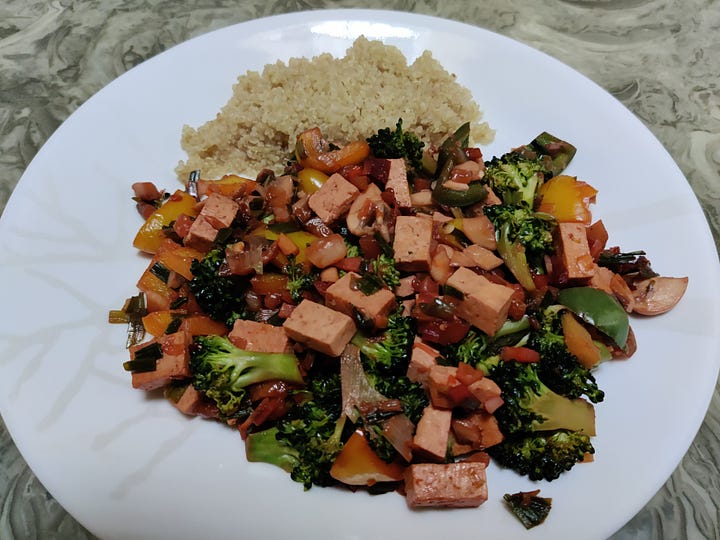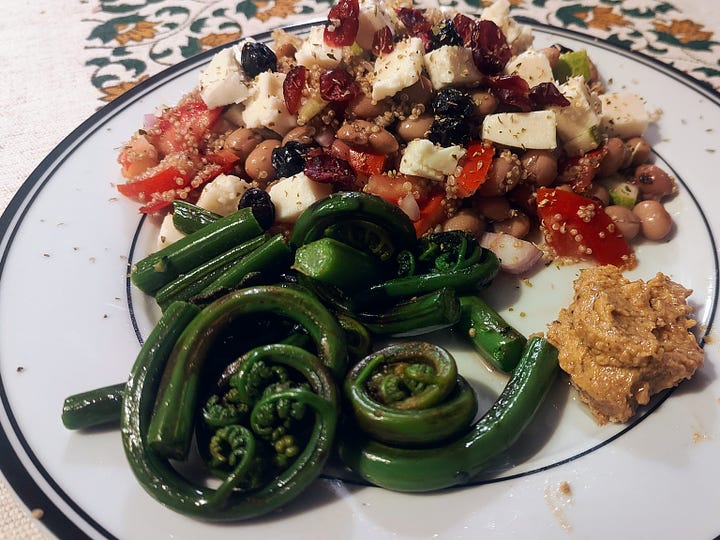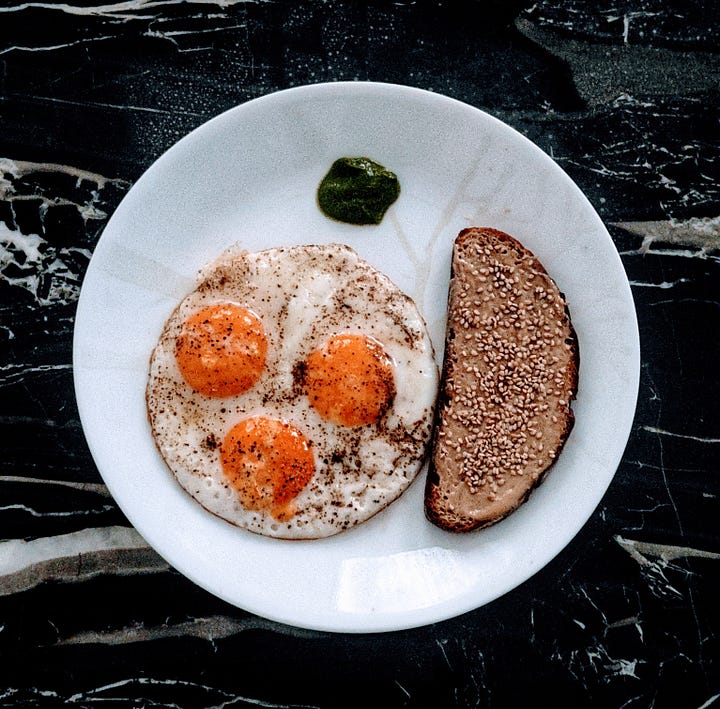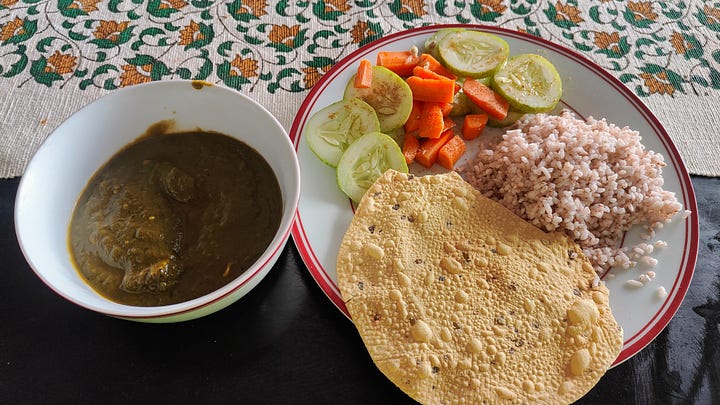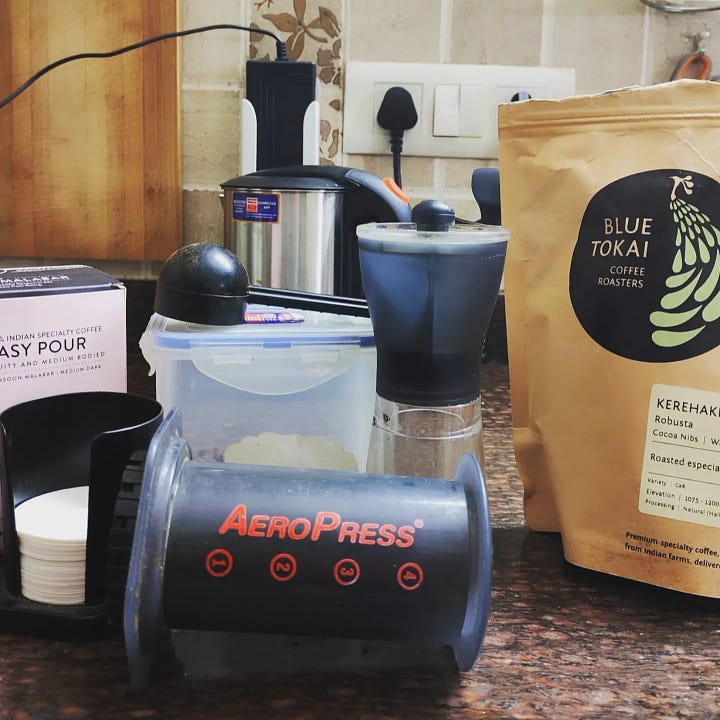Flawed and Fit: Everything I’ve Learned About Staying Healthy
The most trustworthy source of food and
fitness journalism in the country.
For over a year, I’ve spectacularly failed at hitting my fitness goal: dipping below 15% body fat. This was supposed to be my gift to myself on my 30th birthday. Now, nine weeks from my 31st, I’m still hovering around 18-20%.
Confession two: Once upon a time, I thought I was above the whole circus of appearances. I’d preach to anyone who’d listen that I lift dumbbells at ungodly hours because I care about my body, want to be disease-free, and want to feel healthy. And that’s the truth, but not the whole truth.
As it turns out, I’m a very shallow person: I’m utterly fixated on dreaming of a muscular chest that’s currently MIA. And don’t even get me started on how much my stubborn belly fat loves me—it refuses to leave, like a clingy ex who just can’t move on. (It’s a Shakespearean tragedy, really.)
This is me. And this version of me, I’ve now accepted. I’m the guy who wants to be ultra-fit—that <15% body fat goal isn’t going anywhere—but can’t always make it happen. Life keeps happening, and training discipline falls apart.
Which means my chances of gracing a GQ cover—hair wet and wild, funky-coloured buttons-open shirt à la Rocky Randhawa—are about as high as having a sane time on Hinge. But that’s okay. I can live with this. (My ego, however, is still in therapy.)
Now, a plot twist.
Four years ago, I was at 35% body fat. Then, I shed twenty kilos. In seven months.

And then, the naysayers predicted I’d gain it all back.
Guess what? That didn’t happen. Not a single kilo returned. If anything, I’ve only added muscle and feel healthier than ever. I could barely do five push-ups back in the day; now, every week I try to break my bench press records.
This. Is. Progress.
What follows are lessons from a guy caught in this weird fitness limbo: not quite a chiseled guru, not quite a zen master who exercises for inner peace. Just a regular dude balancing vanity and sanity, trying to look good in a t-shirt while also not dying young.
And hey, no fat loss secrets—just everyday principles for being healthier. A roadmap for the ‘Above Average Fit Guy’ who loves food, sees fitness as part of life, and debates politics more than diets.
I. Build a Food Philosophy
Consider this: if you eat three meals a day, that’s roughly 1,100 meals a year.
That’s 1,100 decisions about what to put in our bodies. Yet how often do you think about why we eat?
I didn’t, for the longest time. I was on autopilot, shovelling food into my mouth without much consideration. And then, when I started my fat loss journey in 2020, I started educating myself on nutrition—and everything changed.
I realised we’re obsessed with the ‘what’ (Is A2 milk better than regular milk?) and the ‘how’ (what’s the best high-protein recipe?), but we rarely pause to consider the ‘why’.
And it matters the most, because the ‘why’ shapes your food philosophy, which then guides decisions on ‘what’ to eat and ‘how’ to eat.
Mine is simple. Food serves three purposes in my life:
Fuel: It’s the energy that powers my body. It’s what allows me to feel vibrant, tackle my goals, and nourish my body to perform at its best.
Pleasure: It’s the joy of a perfectly cooked egg, the explosion of flavours in a spicy curry, the comforting aroma of my morning coffee.
Culture: It’s the chole poori on Diwali, chocolate cake on birthdays, and the window into different worlds through their culinary traditions.
All three matter. The trick is finding the right balance. My approach:
- Nutrition is the primary function of food, so it’s the focus of most of my meals. That’s what I optimise for daily.
- Pleasure should be occasional. Overindulge, and you lose the specialness. It becomes mundane.
- Cultural aspects are situational. They’re important but not an everyday affair.
This is my framework, which aligns my food choices with my fitness goals while still honouring the full spectrum of what food means to me.
A framework like this makes it easier to navigate the countless eating decisions you face every day.
II. Food Rules
Once you’ve nailed down your ‘why’, it’s time to tackle the ‘what’. And boy, is that a minefield of conflicting advise. Endless IG reels and Twitter threads scream “Eat X, not Y!” (Enough to make your head spin.)
Don’t fall for it. Drowning in isolated tidbits will leave you perpetually confused and always reliant on some guru to guide your food choices. (Why we’re not taught nutrition in school is a pet peeve, but I digress.)
My suggested game plan on navigating the nutrional maze:
1. Give yourself permission to screw up: Facing a food decision and don’t know what’s better? Relax. Do what feels right, keep that question in your head, and figure it out later. Read about it. If it’s confusing, check what people you trust advice. Follow that. If you find a flaw there later, change. Learn by trial and error.
2. Embrace the obsession phase: Being healthy is a skill. It requires a few months of mad obsession to really grasp it. Fair warning: this phase is insane. You’ll learn about nutrition, how it affects your body, and suddenly want to educate everyone you meet. You’ll judge everyone’s plates without realising you’ve become that bore no one wants to hang out with anymore. (True story, folks.)
3. Shift your baseline: Think of it like driving. The first few weeks are tricky, but then it becomes second nature. Fitness enthusiasts aren’t always stressing over decisions—they’ve just internalised the basics.
4. Count calories and macros for a month: I know, I know—calorie counting sounds about as fun as a root canal. But hear me out: dedicate just one month to tracking your calories and macronutrients. It’s like putting on nutrition glasses. Suddenly, you’ll see: That your “light snack” is actually a meal in disguise. That fancy frappuccino? It’s not coffee—it’s dessert. Those “healthy” granola bars? Sugar bombs in disguise.This isn’t about restriction—it’s about awareness. Once you know that your daily needs hover around 2000-2500 calories (give or take), and an average meal is 500-600 calories, you’ll have a mental benchmark. You’ll make informed choices without needing to track calories forever. It’s like learning to read nutritional labels in real life.
5. Focus on the fundamentals: Once you’ve nerded out, you’ll realise most experts agree on the few things that matter most. For the rest, don’t stress. Let the scientific understanding evolve. And meanwhile, choose what seems best to you and adjust as you learn.
After all I’ve learned, I’ve distilled it down to these essentials:
Eat protein in every meal: Protein is crucial for muscle repair, growth, and satiety. It’s the building block of your fitness journey.
Aim for 1g/kg of body weight (1.5-2g/kg if you’re into heavy lifting).
My daily target: 80-100g. Here’s how I hit it:
25g from whey protein. That’s one scoop. I sometimes have this with 200ml soy milk, which is another 6-8 gms of protein.
18g from eggs. (One egg has six grams. I eat three. And yes, eat the damn yolk! It’s 2024!)
20g each from two meals with either dairy (paneer) or soy (tofu).
That’s around 80-90 gm protein, fixed. The rest comes from whatever else I eat. Yes, this restricts daily choices. But so be it. (Read more about how to meet protein targets here.)
Eat (lots of) veggies: They pack essential nutrients and fibre, keeping you full and healthy.
At a minimum, have the traditional Indian salad—cucumber, tomato, and carrot—with your meals.
Better yet, make veggies the star. My go-to: one-pot meals with veggies, a source of protein, and a sauce or gravy I find delecious, cooked with red rice or quinoa.
The best? A proper salad as a meal. I love’em. (Wait, have you been lucky enough to eat at Bombay Salad Co in Bandra? They make salad a culinary delight. Oh my. And hello, this is not an ad. Just fandom.)
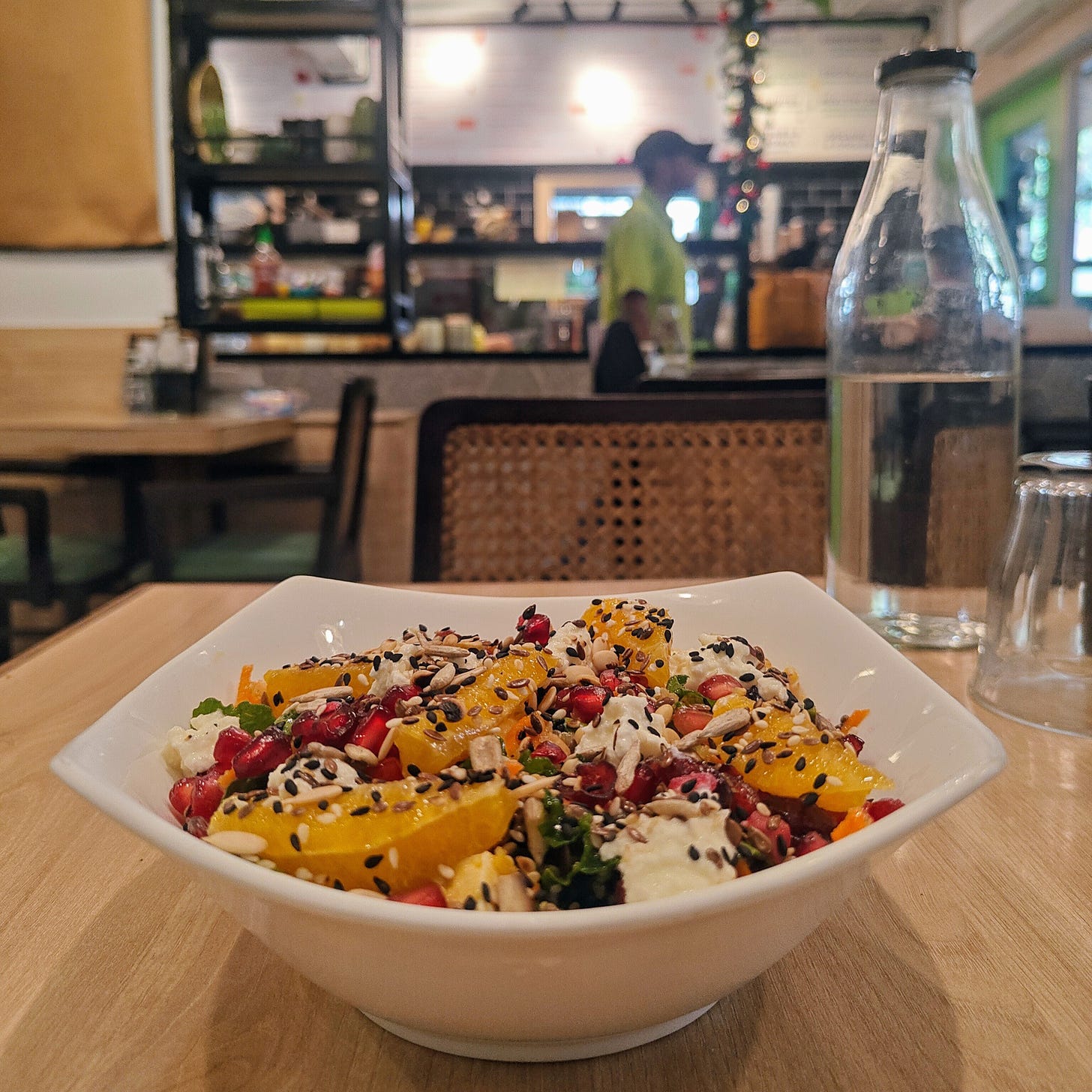
Choose complex carbs: Carbs aren’t the enemy, but choose wisely. Go for complex carbs. They provide sustained energy and better nutritional value.
1. Whole wheat rotis and wraps instead of maida.
2. 100% whole wheat or sourdough bread instead of factory-made white bread.
3. Red rice or quinoa instead of white rice.
Include healthy fats:
1. I cook with olive oil instead of refined oils.
2. Snack on nuts like almonds, cashews, and walnuts. Nut butter spreads on bread—yum! But remember, they’re calorie-dense little devils. Mind the quantity.
Stay hydrated: Drink water. Lots of it.
That’s about it. Play around with this. And most of your meals—for nutrition—would sort themselves out. These rules form the foundation of my eating habits, but flexibility is key.
Always remember that the best diet is the one you can stick to. I tried going very low-carb a few months ago, and while my body did feel really good in the two weeks, I just couldn’t follow it through. Failed experiment.
And that’s the point: adherence matters the most. No matter how many kale smoothies you force down, if you can’t maintain it, it’s pointless.
III. The Extras: Sugar, Caffeine, and Supplements
The sweet dilemma: Listen, it’s a bit controversial, but sugar isn’t the devil. It’s in fruits, dammit! We’ve been eating sweet stuff since we figured out climbing trees was a good idea. It’s natural to like sweet—it’s one of our five taste buds, after all!
The problem? We got too clever for our own good. We started extracting sugar, stripping away the fibre it naturally comes with, and then sprinkled that refined sugar on everything like it was fairy dust. (It wasn’t.)
Now everything’s practically candy. Too much sugar everywhere. Here’s my sugar strategy:
1. No sugar in my kitchen. No artificial sweeteners either.
2. My magic number: 25g of sugar per day, max—based on science. (Some say up to 50g, but I play it safe.) Preferably from natural sources like fruits or dates.
3. Dark chocolate is my kryptonite. 70% cocoa is my sweet spot. A couple of squares with afternoon coffee? Pure bliss.
4. Desserts are for special occasions or when they’re so damn good they’re worth the splurge. (Special place in hell for those who make terrible desserts—sugar better be worth it!)
Remember: Occasional refined sugar won’t hurt. But that sneaky sugar in your daily chai, biscuits, and after-dinner treats? It adds up faster than your subscriptions-you-don’t-need bill.
Caffeine obsession: I started drinking black coffee to look cool. (When did I say I’m above all this?) Now it’s an expensive hobby and a morning ritual I can’t live without. I practically spend 64.5% of my life in coffee shops. (Is this the point at which I get to say… follow me on Insta for recos?)
My caffeine rules:
1. Science permits up to 400 mg a day. That’s about 4 cups of brewed coffee.
2. I (try to) cap mine at three: early morning, mid-morning, and early afternoon. No caffeine after 3 pm. (Exceptions happen. Broke that rule while writing this article. The irony.)
3. I like my coffee black. No sugar. No milk. Just pure, aromatic bliss. And almost zero calories.
The cherry on top: Quick rundown on supplements:
1. Whey: Already mentioned. One scoop a day does the trick for me. (Read more.)
2. Creatine: Yes, 5g a day, but best only if you’re into lifting. It’s like a turbo boost for your muscles. (Read more.)
3. Multivitamins: Not needed, generally. Check for vitamin deficiencies and fill in what you don’t have — no need for these supposedly magical pills. (Read more.)
Remember, supplements are just that — supplementary. They’re not a replacement for a solid diet and consistent training.
Alcohol and smoking: No beating around the bush—no amount of alcohol or smoking is good for you. Period. I’m no expert here—and glad not to be one. Never tried, never been curious. Call me boring, but my liver thanks me.
IV. When Rules Meet Life
Rules are great. But then life happens. Zindagi. As if the universe has a personal vendetta against my carefully crafted plans—always trying to increase entropy and make the world go wild.
How to deal with this absurdly messy thing called life while trying to stay fit? My survival guide follows:
Embrace the boring: Twenty-something me would laugh at thirty-something me finding joy in the monotony of existence. But here we are. Boring is beautiful, folks.
I love food, but when it comes to nutrition, I’m cool with the same eggs every morning. Variety is great, but so is convenience and hitting those nutritional targets. I save the culinary adventures for my indulgence days.
The rest of the time? Give me my predictable, tasty, nutritious meals. No bland food though – I’m not a monk.
Home vs. outside food dilemma: There’s this idea that home-cooked meals are angelic and restaurant food is the devil. The truth is complicated. Sure, cooking at home gives you control over ingredients and hygiene. But let’s be real – sometimes life (or our cooking skills) doesn’t cooperate.
I live solo, and whipping up three perfect meals a day? Not happening. So I found a middle ground. I outsourced my lunches to a salad subscription service. Why?
Because I can’t for the life of me make salads that are delicious and nutritious every day. It’s not laziness, it’s strategy. The key is finding trustworthy places that align with your nutritional goals.
The art of strategic planning: Got a dinner at your relative’s place? Or a date at that new Thai restaurant? Don’t panic. Here’s my secret: I eat lighter earlier in the day. It’s like creating a calorie buffer. This way, I can enjoy that rich meal guilt-free. The body is surprisingly adaptable—as long as you’re not pulling this trick every day.
On emotional eating: Let’s get real. You know those times when life plays whack-a-mole with your emotions? Like… the humiliating feeling when you have sent that text to your crush and they leave you on seen?
In that moment of crushing defeat, my brain isn’t screaming for kale. It’s demanding carbs, sugar, and a side of self-pity. Sometimes, I give in. And I have learnt not to beat myself up over it. Because while I know the solution to my emotional problems isn’t at the bottom of an ice cream tub, but if that ice cream is the hug I need to get through the moment, so be it.
Because we’re humans. And food isn’t just fuel—sometimes it’s comfort. Enjoy it if you’re going to have it, and then gently guide yourself back to your usual habits.
The key thing to remember: One slip-up doesn’t derail your entire health journey. It’s not about being perfect all the time; it’s about being consistent most of the time.
Think about it: Remember you are eating 1,100 meals in a year, not counting snacks. Now if you make less-than-ideal choices 10% of the time — that’s more than 100 meals a year — you’re still winning 90% of the time. That’s an A-grade in any book!
I am very clear on this: my fitness goals should serve my human needs, not the other way around. And so far? It’s working pretty well. (Who knew being imperfectly healthy could feel this good?)
V. The Exercise Odyssey
Almost everyone knows why we should exercise, but most people I know don’t. They want to, but can’t. And I see so many often get stuck thinking about the ‘best’ exercise — is it running? Or some sport? Yoga? Gym? But then what to do in the gym? Weights? With dumbbells or machines?
My journey before 2020 was a rollercoaster of starts and stops. I’d have phases of regular exercise, then nothing. I’d join a gym, then ghost it. Or I’d go for that occasional run, feeling like a fitness god for a day, then… nothing for weeks.
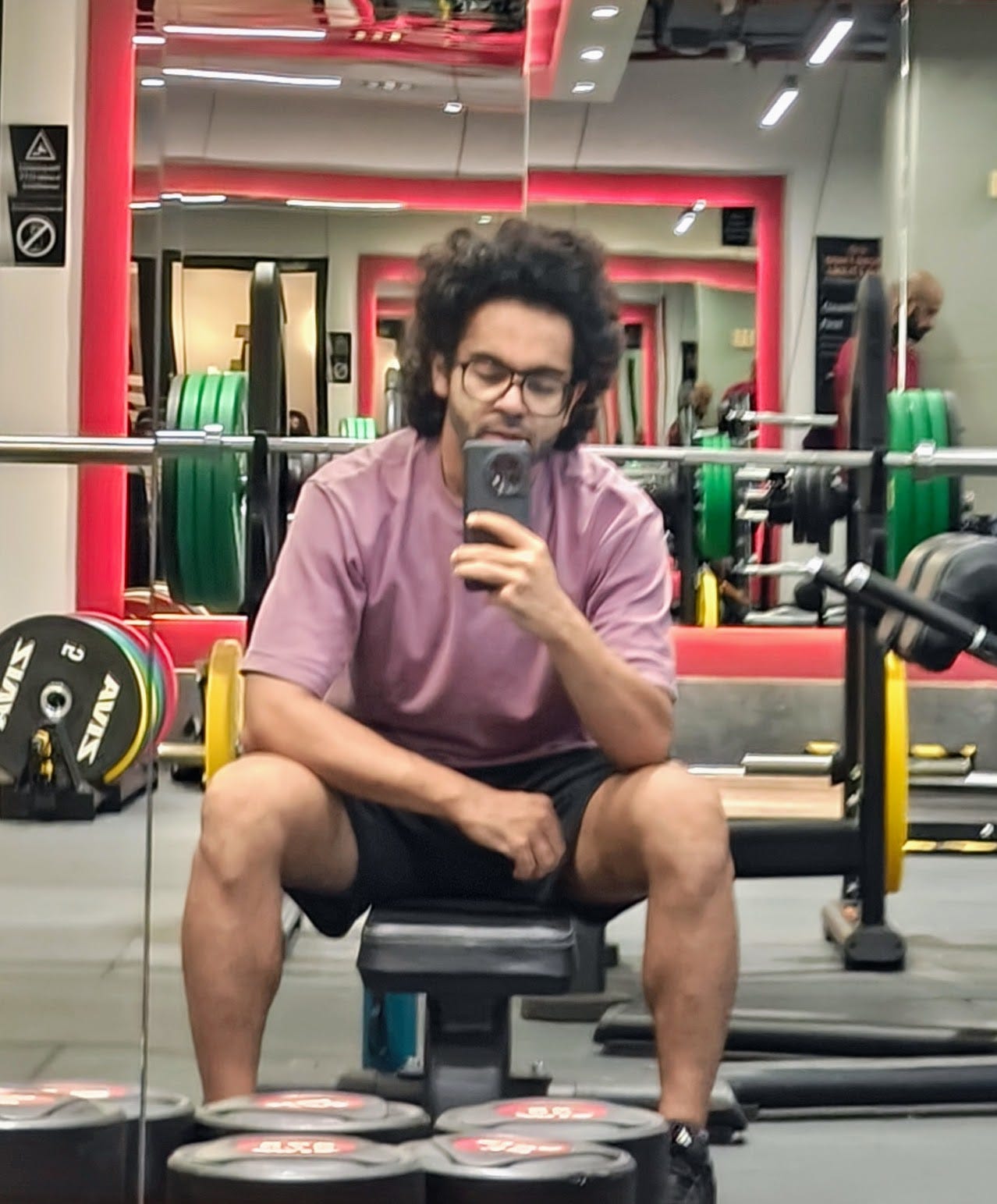
Here’s a rough sketch of how my exercise journey evolved:
Group Classes: Thank you, Cult.Fit! The group class format was my saviour. Sometime in 2019. It was fun, social, and best of all, I just had to show up. No decisions, no equipment anxiety, just follow the instructor and try not to fall over.
Zoom workouts: When COVID hit, I discovered Zoom workouts. Perfect for my basic fitness level. Bodyweight exercises, strength training for fat loss—huffing and puffing in my living room. No excuses about gym commutes. I don’t workout at home anymore, but will always be an evangelist—because this got me through my fat loss.
Home equipment: Progress demanded more. I invested in some home dumbbells, feeling like a proper fitness buff. I started following more structured weeks-long strength training programs available online.
52-week milestone: June 2021 marked a personal best. 52 consecutive weeks of exercise. No breaks. I could finally say, “Yo! I’m into fitness! Here’s proof!” (Yes, me—the irritating hostel roommate who would never go to the first floor to fill the water bottles.)
Mountain life: I lived in a mountain town for three years, and it taught me to adapt. No good gym? No problem. Home workouts, runs, and lots of walking kept me going. (What’s better than hiking?)
But it wasn’t all smooth sailing. There was a four-month period where I barely worked out, and the guilt was real. I felt like a fitness fraud. But it taught me a valuable lesson: our exercise routines go through phases. There are times when you will miss a day. Or two. Or a week. Or two. Or a month. Or two. Not ideal. But it happens. Just get back when you can.
Gym junkie: I’m in my best phase yet. I’ve discovered the joy of a structured weightlifting routine with a Push-Pull-Legs routine. The best thing I did was hiring an excellent personal trainer who taught me the basics of lifting properly and made me confident in the gym — and now I train by myself, loving the repetition of squats, deadlifts, and bench presses, and chasing those PRs is my new addiction!
My key lessons all this while:
1. Morning workouts work best for me. Wake up, have coffee, go to the gym and start my day.
2. Time is not an excuse. If it’s a priority, you make time. When I try to bluff myself, I think about Barack Obama’s routine, and his daily hour in the gym for four days a week when he was the President of the United States. (I love my work, but clearly, he had much more going on.)
3. The best exercise is simply the one you’ll actually do. Yes, there might be some optimal workout plan out there, but if life circumstances don’t allow you to follow it, what’s the point?
4. Add movement in everyday life. Especially walking. Take the stairs in the office. Skip the elevator in the train station. Walk while on calls. Do meetings while walking. Body loves it.
That’s my journey so far. I’m now diving deeper into exercise science to further my progress.
But notice the evolution? This all happened over a five-year period. Everyone has a different starting point, and exercise journeys are deeply personal. It would be ridiculous for me to feel intimidated by someone who’s been lifting for ten years—we’re simply not on the same page.
VI. Non-Advice On Sleep
If you’re into fitness, you’ve heard this endlessly — food, exercise, and sleep are the three pillars of fitness. It’s the holy trinity of health, the trifecta of wellbeing, the… you get the idea.
My groundbreaking advice on sleep: I have none. Zero. Zilch. Nada.
Why? Because I sleep like a baby. A very large, adult baby who doesn’t wake up crying for milk at 3 AM.
I don’t track my sleep with fancy gadgets, so I have no empirical data on my sleep quality. I just know that I sleep really well. And I wake up on time. Without an alarm. Yes, there are odd days where sleep is screwed, but that’s rare enough that I never had to work on it.
It also feels like that one part of the fitness trio where I have the least control—at least relatively speaking. I can force myself to eat broccoli or lift weights, but I can’t force myself to sleep.
So if you’re struggling with sleep, it’s definitely something to work on.
How to get good sleep? Read this and this.
Or maybe ask someone who’s conquered insomnia. Or a really contented dog. (They seem to have it figured out.)

VII. Famous Last Words
Okay. Wrote a lot. (Hello? Are you still here?)
Now what’s expected? I guess I have to do what every piece of fitness advice must ritually do? Motivate you? Give you some inspiration?
Samarth stares at people around at the coffee shop after breaking his 3pm cut-odd caffeine rule: ‘What should I end this with?’
I’m not great at motivational speeches. (Don’t attend my TED talk.)
But you know what? Let’s forget about the clichéd pep talk. Instead, let me share some genuine reflections on how fitness has changed me—beyond just the physical aspects. Some sharp changes you might experience if you plunge into fitness.
First, fitness made me proud of my body: Its adaptability surprised me. The hardest part to describe? It’s not the visible changes or reduced disease risk. It’s the daily feeling. Higher energy levels. Better posture. Stamina to do more. Hiking without huffing. Enjoying physical activities. Not falling easily. It all adds up.
Your body adapts in surprising ways. You grow up hating veggies, then suddenly crave them. You’re addicted to sweets, then you cut back and your body stops demanding them. This might not work for everyone—some genes are stubborn conspirators—but it worked for me. Beyond all the superficial reasons for which I do what I do, I lift and eat well out of sheer respect for this body that supports me.
Second, fitness made me kinder: To myself. To others. To all of us pushing against the chaos of modernity to do what’s best for us. The gym shame when you see the more experienced dude lift 3x what you can? It’s real. The envy of abs so defined you could grate cheese on them? Yep, been there. The frustration of someone who eats whatever they want and looks like a Greek god? Oh boy. And don’t even get me started on the self-loathing mid-workout wondering if you’re making progress. It’s a mental rollercoaster.
But then you realise… it’s a journey. I’m far behind the folks who seem to have cracked it. But yet, I am quite far ahead. And when you see others trying to be healthier, you want to help. You see yourself in them. You feel kinder towards them—and to yourself. For coming this far.
And third—a point I’ve been thinking a lot about—failure. That’s where I started this post—who wants to think about failure? Who wants to do anything only to fail?
But strangely, failure is exactly what’s needed at the gym. Every time you lift, you chase failure. If you’re not struggling in the last rep, you can’t grow. You feel the high when you push beyond your best, but repeated failures are also needed. Growth lies in forcing yourself to face the possibility of failure—in attempting things you can’t quite do today but aspire to master someday.
And that’s the paradox: you don’t want to fail, but you have to work every day towards failure to avoid failing in the long run.
This applies to everything fitness—learning about it, eating well, exercising well, sleeping well. And I guess, that applies to everything in life? Perhaps.

